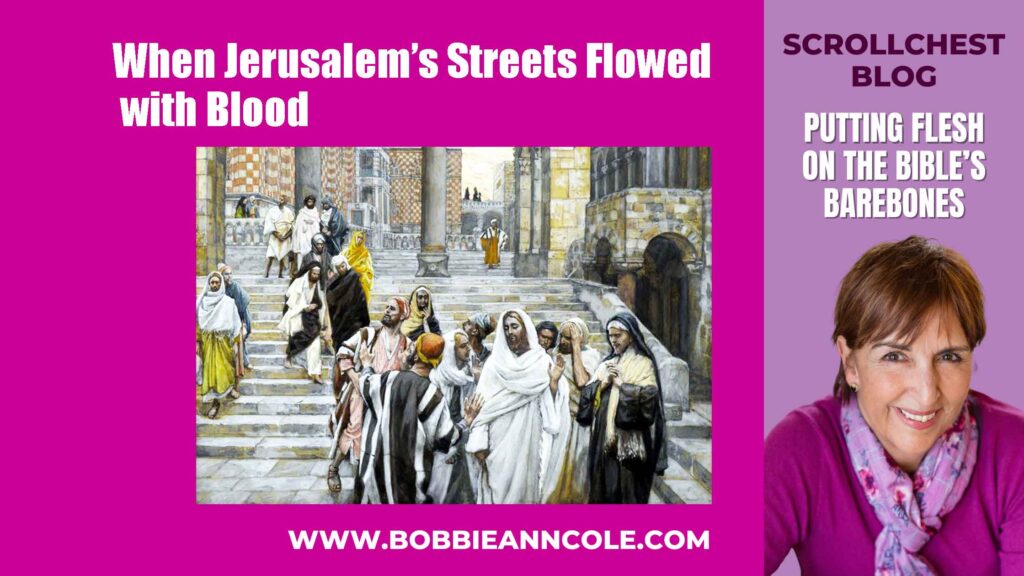Why do Jews commemorate TISHA B’AV, (9th of the month of Av), which falls on July 27th this year? It marks the destruction of the Jerusalem Temple, twice over, on the same day. It’s a solemn fast day, considered one of the most significant and mournful in the Jewish calendar. What happened then?
The first Temple was built by Solomon in the 10th century BCE. It stood for some 400 years before its destruction by Babylonian King Nebuchadnezzar in 586 BCE. He subsequently carried off many Jews in exile.

The second Temple was a rebuilding effort initiated by Persian king Cyrus the Great later in the 6th century BCE. It was lavishly renovated and expanded by Herod the Great in the 1st century BCE, when it became known as Herod’s Temple.
Although Herod was hated, the Temple became the pride and joy of the Jewish people, including Jesus’ disciples. One of them said, as they were leaving the Temple one day, ‘“Teacher, look at these magnificent buildings! Look at the impressive stones in the walls.”
Jesus replied, “Yes, look at these great buildings. But they will be completely demolished. Not one stone will be left on top of another!”’(Mark 13:1-2)
He was right. The glorious temple, famed for its white stone that dazzled in the Jerusalem sunlight, and for the gorgeous patterned floor tiles of its vast Court of the Gentiles, would be obliterated by the Romans in 70CE, during the First Jewish-Roman War.
SIEGE
The bloody sacking of Jerusalem that accompanied this event led to a second exile of the Jews from their homeland, one that would last nearly 2,000 years. It ended with the formation of the modern State of Israel in 1948.

These events are described by Jewish historian Flavius Josephus, an eyewitness of the destruction, in his work, The Jewish War. He described brutalities on both the Roman and Jewish sides, with some Jewish factions fighting against one another.
A months-long siege by the Romans resulted in widespread starvation, suffering and violence. The Romans built battering rams and siege towers while, inside the city walls, those that remained resorted to gnawing on leather belts and stuffing tufts of grass into their mouths.
Eventually, according to Josephus, the Romans breached the city walls to “joyful acclamations for the victory they had gained… Seeing nobody to oppose them… they went in numbers into the lanes of the city with their swords drawn. They slew those whom they overtook without and set fire to the houses whither the Jews were fled, and burnt every soul in them, and laid waste a great many of the rest… and made the whole city run down with blood, to such a degree indeed that the fire of many of the houses was quenched with these men’s blood.”
THE DESTRUCTION OF THE TEMPLE
They torched the Temple, destroying it completely. Many Jews were killed or captured, and Jerusalem was left in ruins. The Romans carried many of the Temple’s treasures of silver and gold back to Rome.
The Jews were left bereft not only of an important place of gathering and debate but of the very centre of their connection to God. There was now nowhere to worship God by making the sacrifices He required in Torah (the Pentateuch).
“And when they were come near the holy house, they made as if they did not so much as hear Cæsar’s orders to the contrary: but they encouraged those that were before them to set it on fire. As for the seditious, they were in too great distress already to afford their assistance [towards quenching the fire]. They were every where slain, and every where beaten. And as for a great part of the people, they were weak, and without arms, and had their throats cut wherever they were caught. Now round about the altar lay dead bodies, heaped one upon another; as at the steps going up to it, ran a great quantity of their blood: whither also the dead bodies that were slain above [on the altar] fell down.”
The Jewish War Book VI Ch.4.
All that remains today of the great Temple is the Western Wall, formerly known as the Wailing Wall. Great numbers of Jews— and some Christians— pray there, tucking little letters to God into the cracks in the wall.

THE BURNT HOUSE
One destroyed dwelling from that time, preserved beneath a layer of soot and ash until it was discovered in the 1970s, is The Burnt House, also known as the House of Kathros. It is one that Jesus and his disciples may have been familiar with.
The cement outer walls of the Burnt House would have been covered with a thick, white plaster. The floors were of beaten earth, with sunken ovens of clay set in them. There is no doubt that the house, consisting of four rooms, a courtyard, a kitchen and a mikvah, used for ritual immersion, was luxurious by Jewish standards.
The presence of a personal mikvah also supports the contention that the owners were a priestly family.
The Kathros family is mentioned in the Talmud, the Oral Law, as priestly producers of incense for the Temple. Jugs, bowls and measuring vessels found in the house support the idea that a perfume-producing workshop existed here. Intriguingly, the Talmud reports that the Kathros family abused their position.
In the kitchen, a stove, a grinding stone of basalt for milling grain and pressing olives and stone jars have been found. This stone kitchenware further supports priestly occupation, because a household observant of Jewish law would have preferred stone to pottery. Items found inside more modest houses have generally been of clay, a material less easy to keep kosher.
Inside, scattered fragments of stone tablets, ceramic and stone vessels, iron nails, shelves and furnishings, burnt ink wells, oil lamps from the Roman period and other household objects have been recovered.
The bones of a woman approximately twenty-five years old have been discovered, as well as an iron spear that she may have brandished against the Romans. Perhaps she was a perfumer.
Might the woman who lavishly poured perfume from an alabaster flask over Jesus’ head have purchased it from the Kathros? Might she even have been a perfume maker herself? We know it was women’s work. Samuel warned that, if Israel opted to have a king, that king would, “take your daughters to be perfumers,” (1 Samuel 8:13).
While the Burnt House can take us back to AD70, the Temple Institute exists to take us forward, to what they hope will be a future rebuilding of the Temple.
A GIANT MENORAH

The Temple Institute in Jerusalem is preparing to rebuild the Temple and re-establish Temple practices, including animal sacrifice. It has begun by making Temple treasures such as the magnificent, solid gold, seven-branch menorah candlestick that stands on public display near the Western Wall.
Composed of rabbis, scholars and craftsmen, the organization studies ancient texts and works with experts in various fields. They also offer educational programs and exhibitions to promote awareness and understanding of the significance of the Temple.
The problem is that the original location of Herod’s Temple is the stunningly beautiful Dome of the Rock, a sacred place to Moslems for well over a thousand years. The Dome marks the spot from which they believe their holy prophet, Mohammed, ascended to heaven.
It is the self-same rock that Jews believe bore the altar on which Abraham prepared to obediently sacrifice his only son, Isaac, in a demonstration of faith in God’s promise to him that his descendants would be as numerous as the stars.
TISHA B’AV
On the 9th of Av, observant Jews come together with gestures of mourning for the loss of the Temple and for reflection. They fast from sunset to sunset, abstaining from both food and drink, in a similar way to Yom Kippur, the Day of Atonement.
They refrain from pleasurable activities such as bathing, wearing leather shoes or using lotions or perfumes, as well as marital relations. They even deprive themselves of the joy of reading Torah. Instead, the Book of Lamentations, from the Prophets section of the Hebrew Bible, is read in synagogues and at home, a book that expresses sorrow and grief over the destruction of Jerusalem with its Temple.
Kinot, elegies and dirges that recount Jewish tragedies past, as well as special prayers of mourning, are recited. Observant Jews sit on low, (uncomfortable) stools, demonstrating humility and grief, as if they were sitting Shiva, Jewish mourning of the dead.
The overall tone of the day is one of reflection and grief, as Jews express their longing for the restoration of the Temple and their ultimate redemption.

Don’t forget to sign up in the sidebar to be the first to hear about my new posts here on Scrollchest.com.. You will receive my 5-Minute coming to faith Testimony: HOW I MET JESUS. It began in a Jerusalem Church where, as a Jew, I thought I wasn’t supposed to be…
Find out more about the joys and challenges of living in Israel as a Jewish believer.


Thank you, Bobble. So sad. But it’s important to know this Jerusalem history.
And to understand why Jews mark the 9th of Av – July 27th this year.
Wow. What an incredibly well written article on this event Bobbie. Thank you for giving us these windows of insight into the history of the Jewish people and the Jerusalem Temple. Your lessons not only give us understanding on things we don’t ever hear about, but they are also quite moving.
Thank you for your encouragement, Gaetane. I love what I do. You seem to be saying that comes through to my reader – which is what every writer desires.
What an informative article! I have been to the wailing wall but I didn’t know all this rich history. Thank you Bobbie
I am so glad it blessed you, Zola.
I am now fascinated with this subject! Write more!
Hi Jan – I love these type of topics. What kind of thing would you like to see more of?
How fascinating ‘The Burnt House’
Incredible history! Thank you for this article Bobby, so interesting. I like the giant Menorah. The miniature, (A ‘diorama’ is a replica of a scene, could I use this word here?) replica of ‘Herod’s Temple. I love it!!! It brings things to life!
How horrific to be burnt in your home! They lived in hard times for sure.
I am learning more and more from you about the Jewish way of living and it is so interesting, thank you Bobbie. God bless you as you continue with His work in your life. I am so blessed by you.
Heartfelt thanks to you, Lynne, for your encouragement. God bless you.